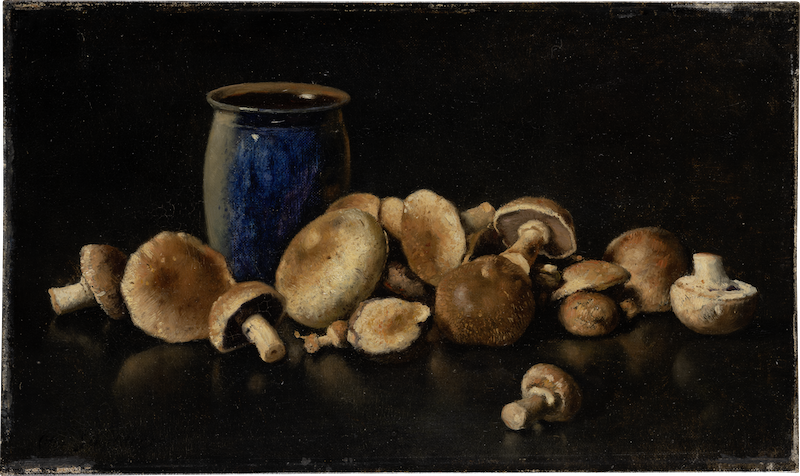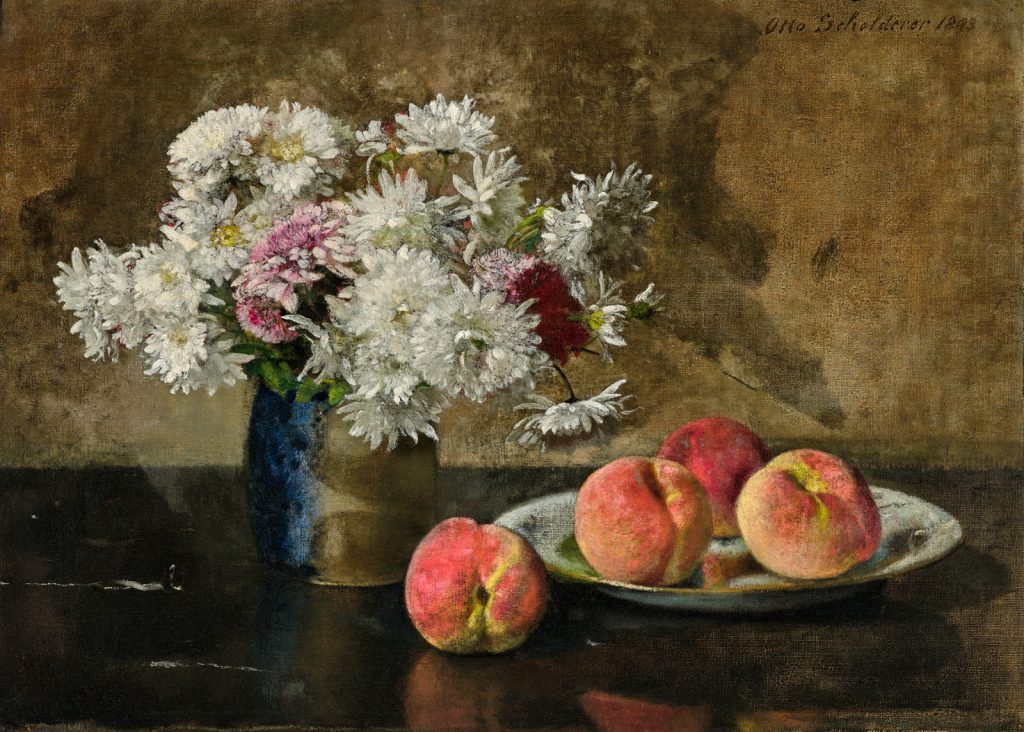Otto Scholderer
(1834 - Frankfurt - 1902)
Chrysanthemums and Peaches, 1893
Oil on canvas, 35 x 48.5 cm
Signed and dated upper right Otto Scholderer 1893
Provenance:
Private collection, France.
Exhibited:
Possibly shown at the Große Berliner Kunst-Ausstellung, Berlin, May 3 - September 2, 1894, no. 1460: as Früchte und Blumen[1]
Literature:
Friedrich Herbst, Otto Scholderer, 1834-1902: ein Beitrag zur Künstler- und Kunstgeschichte des 19. Jahrhunderts, Frankfurt 1934, p. 64, no. 187;
Jutta M. Bagdahn, Otto Franz Scholderer 1834-1902. Monographie und Werkverzeichnis, [inaugural dissertation], Freiburg 2002, p. 75 and p. 287, no. 376.
The second half of the nineteenth century saw the emergence of Paris as the center of European modernism. Artists flocked to the French capital from all over Europe to attend the city’s state art academy, one of its many private painting schools or private academies, while many hastened to rent studio space of their own.
Large numbers of German artists also traveled to France – staying for weeks, months and even years. The Franco-Prussian War of 1870 strengthened nationalist perceptions of German art history, and from then on little was said about the influence of Parisian modernism on German art. Some German artists became entangled in nationalistically charged cultural debate and disputed the stimulating effects of their stay in Paris. Others saw a stay in Paris as a means of escape from the Wilhelmine skepticism about modernism that spawned political nationalism. Some of the work produced in Paris failed to rise above the epigonic but artists such as Frankfurt-born Otto Scholderer, Wilhelm Leibl and a little later Carl Schuch, went on to develop their own unique style.
Otto Scholderer trained at the Städelsches Kunstinstitut in Frankfurt in the 1850s. He traveled to Paris for the first time in 1857, where he was to spend a year, visiting his friend and future brother-in-law Victor Müller who, like Wilhelm Heinrich Füssli and Edouard Manet, was a student of Thomas Couture. It was here that Scholderer was to embark on a lifelong friendship with Henri Fantin-Latour. The correspondence between Scholderer and Fantin-Latour is largely preserved. It offers important insights into Scholderer’s biography and artistic approach. He also shared Fantin-Latour’s admiration for the Old Masters, particularly the still lifes of Jean-Baptiste-Siméon Chardin.[2]
On his return to Frankfurt he came into contact with Gustave Courbet in the spring of 1858. Courbet had been obliged to flee Paris to escape political unrest and was working in Frankfurt in a studio one floor above Scholderer's studio.
Scholderer returned to Paris in early 1868 with his friend Hans Thoma. He was an active member of an avant-garde artistic community that included Fantin-Latour, Manet, Renoir, Monet, Bazille and the writer Emile Zola. Scholderer is immortalized along with his artist friends in a group portrait by Fantin-Latour titled Un atelier aux Batignolles (1870), now in the collection of the Musée d’Orsay.
The impending outbreak of the Franco-Prussian War in 1870 obliged Scholderer to break off his stay in Paris and he moved briefly to Munich to join Victor Müller. This enabled him to renew his friendship with Wilhelm Leibl, working as a loose associate of his circle. In early 1871, he resolved to move to London, where he became engaged to Hildesheim-born Luise Steurwaldt. They were married in 1872. He embarked on a lucrative career as a portraitist. Whereas in Paris he had been active in literary and artistic circles he now lived as something of a recluse – no record of contact to English painters has survived. Although his work was noticed by English critics he failed to achieve a major breakthrough in his lifetime. Why he never returned to his beloved Paris remains unexplained. He did not return to his native Frankfurt until 1899, three years before his death.[3]
The present work dates from 1893 and was executed towards the end of Scholderer’s long sojourn in England. It is a characteristic example of his still life painting, showing his predilection for setting a few objects against a neutral background. The handling of lighting and choice of palette recall the work of the Old Masters. The outlines of objects are hard or soft, depending on the fall of light. The same vase is found in other still lifes by Scholderer, such as the painting Still Life with Blue Vase and Mushrooms (1891), now in the Städel Museum in Frankfurt (Fig. 1). To the right of the bouquet, the bright glow of the peaches is reflected in the highly polished table top. Scholderer shares Fantin-Latour’s refined approach to the treatment of contrasting textures. This approach underscores their mutual indebtedness to Chardin, whose example they sought to emulate. The fuzziness of the peach skin contrasts with the gleam of glazed ceramic, the shine of the polished table top and the restrained, shadowy tones of the wall, which acts as a subtly blended, neutral backdrop for the still life elements.

Fig. 1 Otto Scholderer, Still Life with Blue Vase and Mushrooms, 1891, oil on canvas, 24.8 x 42 cm, inv. SG 385, Städel Museum, Frankfurt
In his later career Scholderer was to shift his interest increasingly to still life painting. Angelika Lorenz notes: ‘(These are paintings) which devote themselves calmly to the appearance and nature of objects, allowing them space in the picture in which they are spread out in dark, luminous colors of subtle refraction.’[4]
While the Impressionists, Scholderer’s friends and associates, moved further towards the dissolution of pictorial objects in the latter part of the nineteenth century, both he and Fantin-Latour remained more firmly anchored in tradition. He combined the delicacy and precision of Old Masterly techniques with a Realist’s interest in the unembellished depiction of everyday objects. But he was also ready to embrace contemporary trends, as demonstrated by the lush arrangement of chrysanthemum blooms, a motif associated with Japonisme, the late-nineteenth century European fascination with Japanese art and design.
1. We are grateful to Dr. Jutta M. Bagdahn, Berlin for providing this information.
2. See Ekkehard Mai, ‘Scholderer im Kontext – Zeitgenossen und alte Meister’, in Otto Scholderer 1834-1902. Die neue Wirklichkeit des Malerischen. Zum 100. Todestag, exhib. cat., Haus Giersch, Frankfurt am Main 2002, pp. 41-8.
3. Mathilde Arnoux, Thomas W. Gaehtgens and Anne Tempelaere-Panzani (eds.), Correspondence between Henri Fantin-Latour and Otto Scholderer (1858-1902), Critical Online Edition 2014, see <http://quellen-perspectivia.net/fantin-scholderer> (accessed December 13, 2023).
4. See Jutta M. Bagdahn, Otto Franz Scholderer 1834-1902. Monographie und Werkverzeichnis, [inaugural-dissertation], Freiburg 2002, pp. 61-80.
5. Angelika Lorenz, Das deutsche Familienbild in der Malerei des 19. Jhs., Darmstadt 1985, p. 251.

